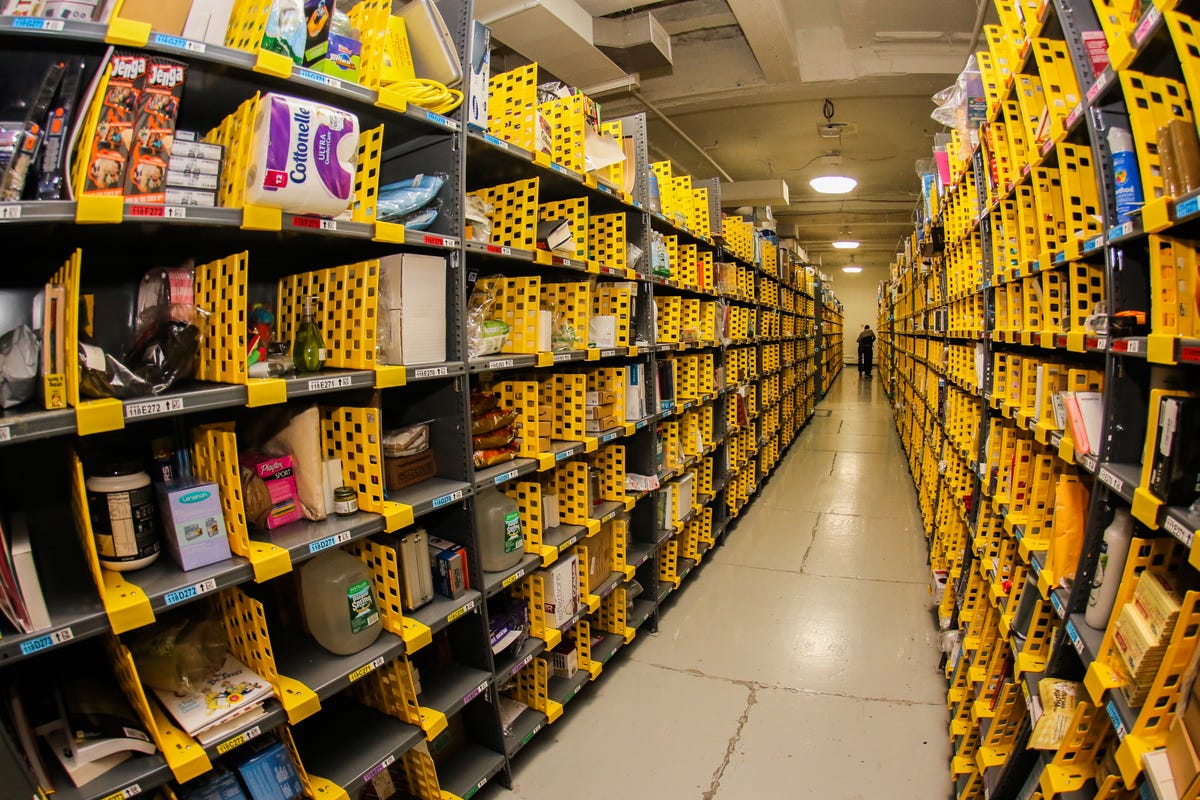Go past the modern, brightly lit lobby of a Midtown Manhattan office building and take the elevator to the fifth floor. There you’ll find Amazon’s secret weapon for drawing in last-minute holiday shoppers.
It’s not a fancy delivery drone or slick new electronic device. It’s a 50,000-square-foot warehouse filled with tens of thousands of consumer products. The busy workspace seems out of place amid the offices, storefronts and bustle of 34th Street below, just across the street from the Empire State Building.
But the warehouse, which Amazon showed off to reporters for the first time ever on Monday, was built in the heart of Manhattan so Amazon can send its Prime members toilet paper or a flat-screen TV in just two hours or less as part of its Prime Now rapid-deliveries service.
“We’re standing right in the center of Manhattan. That’s both a blessing and a challenge,” Stephenie Landry, the worldwide director of Prime Now, said in the middle of the warehouse floor Monday. “This is a pricey place for real estate, but it also means we can get to customers in less than an hour.”


Now playing:
Watch this:
How Amazon’s Prime Now can get an order to your door…
1:50
Prime Now, which is available only to customers who pay $99 a year for Amazon’s Prime membership, is quickly becoming one of the company’s most significant new projects, though Amazon has declined to say how profitable or popular the service has been so far. Amazon hopes to use the year-old service to entice more consumers to skip a visit to the grocery store or drugstore and shop on the Prime Now app instead. Showing off the Manhattan warehouse in the waning days of the holiday shopping season lets Amazon pitch Prime Now as a way for procrastinators to avoid getting grinched on Christmas. This year, Prime Now couriers will be making deliveries on Christmas Eve up until midnight.
Other retailers, such as Target and Walmart, are suggesting last-minute shoppers order online and pick up at their stores.
Prime Now is part of a big push by a handful of tech companies to shave the wait time for online shipments from days to hours, helping reset consumers’ expectations for how quickly they should get their packages. Several other companies, including Instacart, Uber, Deliv and Postmates, are joining the mix to rapidly deliver lunch, groceries or paper towels. Amazon recently bought thousands of truck trailers to move its products around more quickly and is reportedly looking to lease air cargo jets, too, so it can keep building up its logistics operations. Looking to the future, Amazon, Google and Walmart are developing drones that have the potential to deliver packages to customers even faster.
Amazon’s effort to gain more control of its shipping may also help it avoid a repeat of 2013, when US delivery companies were so overloaded with holiday orders that they couldn’t deliver all their packages on time.
Amazon Prime Now: A peek inside the Manhattan warehouse (pictures)






“One of the the things that Amazon is clearly a master at is setting and continuing to reset the bar for what is the best customer experience,” said Daphne Carmeli, CEO of rapid-deliveries service Deliv. “In last 12 to 24 months, the battleground to that customer experience has been the speed and flexibility of purchases.”
At the Manhattan warehouse, dozens of Amazon workers buzzed around tight aisles filled with consumer goods, placing orders inside brown bags lined atop their rolling carts. The assortment on the shelves is random by design to prevent a traffic jam of workers in any one location: “The random sorting actually creates more efficiencies,” spokeswoman Kelly Cheeseman said. On one end of the floor were rows of refrigerators and freezers packed with orange juice, almond milk and ice cream. Every so often, someone would call out “corner” to warn others they were coming out of an aisle, and the rush of activity would heighten when a one-hour delivery popped up.
Amazon opened the Manhattan space, its first urban Prime Now warehouse, last December. Over the past year, the company opened dozens more urban distribution centers, though the Manhattan location remains its only warehouse tucked inside an office tower. The challenge of these spaces has been to condense the company’s typical 1-million-square-foot distribution centers into much smaller locations and decide which items to offer there. Each Prime Now city has different assortments of products to cater to local tastes, with more organic food offered in San Francisco and Seahawks gear stocked in Seattle. Some of the most popular items on Prime Now so far have been Haribo gummy bears in Houston, Ben and Jerry’s ice cream in Las Vegas and organic baby carrots in Portland, Oregon.

The assortment on the shelves at the Manhattan warehouse is intentionally random to ensure there isn’t a traffic jam of workers in any one location. “The random sorting actually creates more efficiencies,” spokeswoman Kelly Cheeseman said.
Sarah Tew/CNET
In 23 US cities, two-hour deliveries are free for Amazon’s Prime members, who get unlimited two-day deliveries of a wider selection of goods and other perks. One-hour deliveries for Prime members, available only in certain ZIP codes, cost $8. Prime Now is also available in parts of the UK, Italy and Japan. Going into next year, Amazon plans to keep growing Prime Now globally.
On the street in Manhattan, courier Sylvester Alderman walked a Prime Now package a few blocks to an apartment building nearby. Other workers use bikes, take the subway, ride on buses or drive vans to deliver orders around Manhattan and Brooklyn.
“I’ve witnessed the volume increase dramatically over the past few weeks,” said Alderman, wearing a Prime Now hat and jacket. “Today was busy. Every day until Christmas is going to get busier and busier.”




